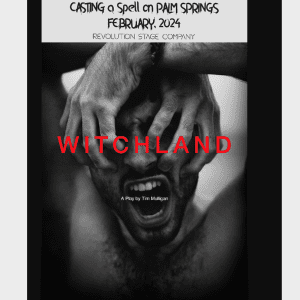 View Winners →
View Winners → ‘King Lear,’ ‘Man of La Mancha,’ Similar Worlds at A Noise Within

Geoff Elliott is King Lear at A Noise Within; Design by RJ Sakai. – Courtesy photo / A Noise Within
By May S. Ruiz
Resuming its 25th Anniversary celebration, ‘Beyond our Wildest Dreams’, A Noise Within puts on a production of William Shakespeare’s “King Lear” which will run in repertory with “Man of La Mancha” later in the spring. Geoff Elliott and Julia Rodriguez-Elliott, co-producing and artistic directors of ANW, have conceived these two shows to be seen on the same day, allowing them to fully speak to each other.
Both shows share the same leading man (Geoff Elliott), the same director (Julia Rodriguez-Elliott) and the same scenic elements, enabling a quick turnover between matinee and an evening performance so the two productions can play on the same stage.
Of the opportunity to perform both Lear and Cervantes/Don Quixote, Geoff Elliott pronounces, “I feel I know Lear. He is stripped of everything, and must face his worst demons to find tenderness and uncompromising love in a very violent world. Lear spends so much of the play terrified of losing his mind. Anyone who goes through a similar self-investigation can’t help questioning his sanity as so much of the world that we live in seems insane.”
Continues Elliott, “In his way, Cervantes/Don Quixote is Lear’s doppelganger. As he assumes Quixote’s persona, Cervantes gains the courage and the strength needed to face the uncertain future of the Inquisition. He, along with his fellow prisoners and, ultimately, the audience are transformed.”
Rodriguez-Elliott says, “In “Lear,” this personal journey of a family dealing with an ailing patriarch has global implications. The breakdown of a nation runs concurrent with Lear’s mental decline. At the beginning of the play, we see a man at the zenith of his power, a modern day dictator who is feared and has never heard the word NO. The world we enter is a violent, callous one. At the end, we see a man transformed.”
The world of “La Mancha” is as violent and callous as it is ripe and crying out for transformation. “Though many often associate “Man of La Mancha” with elaborate set pieces and fanciful costumes, its earliest stagings were sparse, encompassing the spirit of a rag-tag band of prisoners putting on a play with found objects,” explains Rodriguez-Elliott. “I wanted to return to those roots. Based on real-world prisoners, the conditions we’ve created for Cervantes and his fellow inmates are recognizable and terrifying.”
Audiences will likewise be transported to these worlds, in large part, because of the actors’ excellent portrayal of the characters they will inhabit for the next two hours. However, stage plays are a collaboration among many – actors and directors; as well as designers, which include costume, lighting, and set – and their success depends on how seamlessly these collaborators work together to create one magnificent piece.
That “Lear” and “La Mancha” also share artistic team members – Fred Kinney (scenic), Angela Balogh Calin (costume), and Ken Booth (lighting) – makes for an exciting experience for the audience and for everyone involved in both productions as well.
Booth, ANW’s resident lighting designer, who has worked on over 40 productions for ANW since 1998 says, “I’m thrilled to be a part of it; this kind of challenge doesn’t happen a lot in small theatres. For “Lear” I am using a palette of warm and cold lighting, often in combination. You don’t really see the source of light but it’s there being filtered through some unknown artificial source. Shifting the temperature of the lighting within a scene helps to punctuate or accent a moment. Highlighting one particular character helps create dramatic conflict within that character.”
“Lighting defines and redefines the performance space; it can influence the mood for the play and the audience. It enhances the atmosphere for the actors who are on stage to share their art and emotions with their audience,” Booth adds.
“Both “Lear” and “La Mancha” deal with a man with delusions of grandeur. The conflicts in both come not from without but from within the characters – their inner dilemmas of importance and immortality that affect them. To connect both stories, I will create lighting that seems omnipotent in certain scenes and confining for others. Beyond the giant set wall the plays share, you only see shafts of light that emanate from behind a window or door whenever it is opened. The wall is the horizon – there doesn’t seem to be an outside world – and for the most part the lighting of the wall is the same: a cool or bluish wash, beams of warm light seeping down; and a filtered break-up catching parts of it.”
Angela Balogh Calin, resident costume designer for ANW, has worked with Booth since 1998. She says she hasn’t done many shows when Booth didn’t light. “We go back a long time,” she declares.
“Both “Lear” and “La Mancha” are going to have modern setting so costume-wise, I will give them a modern approach,” Calin discloses. “The clothes will be something the audience will be able to identify with; they will be easily recognizable. “Lear” will be eclectic, with 1950s flair.”
“Lear” and “La Mancha” will only be Fred Kinney’s second and third shows with ANW. An independent scenic designer, he was contracted for both shows last spring and immediately did his research.
“I think Shakespeare’s work is better heard not read; so I watched a couple of film versions of “Lear” before I started conceptualizing the scenery,” Kinney reveals. “For “La Mancha,” I listened to the music and then watched the film. Then I came up with a concept that could work for both but different enough. They are unified in theme but the design will have enough variety to service the individual parts of the shows – the things that are unique to each production. I will have a base layer to which I can add elements to make the scenery distinctive to each.”
ANW provides a unique environment in which artists work together across decades. They are comfortable experimenting, trying new things; impressing as much as supporting each other show after show. These artistic relationships inform each of this repertory theatre company’s many exceptional productions for 25 years.
Booth expresses says it best when he says, “I want our audiences to remember what an otherworldly universe we created within our theatre for our interpretation of “King Lear” and, hopefully, they get a satisfying feeling of bittersweet closure. This is what I find exciting – the collaboration in putting on a production – to take a blank stage and create a beautiful picture that is like a painting come to life using the limited tools at our disposal.”









































































































